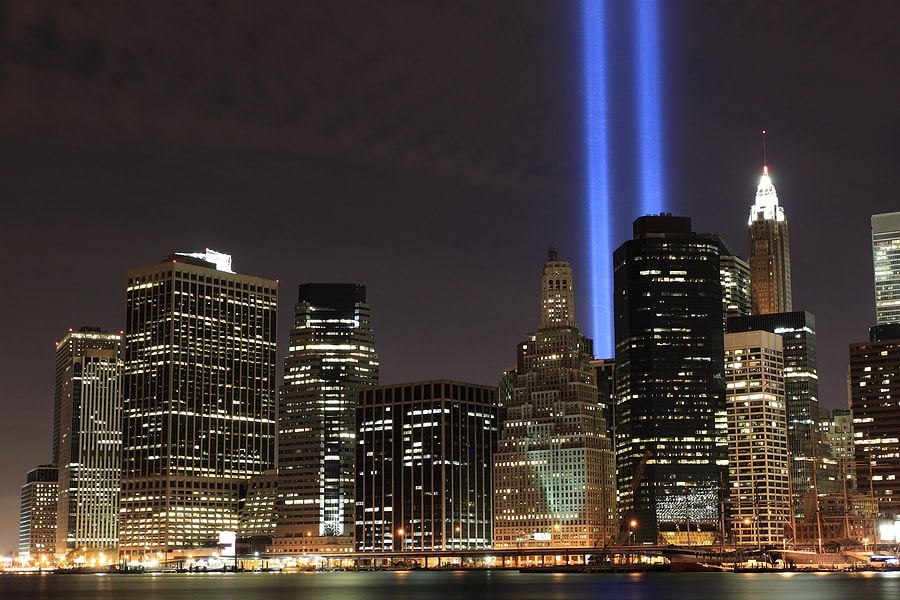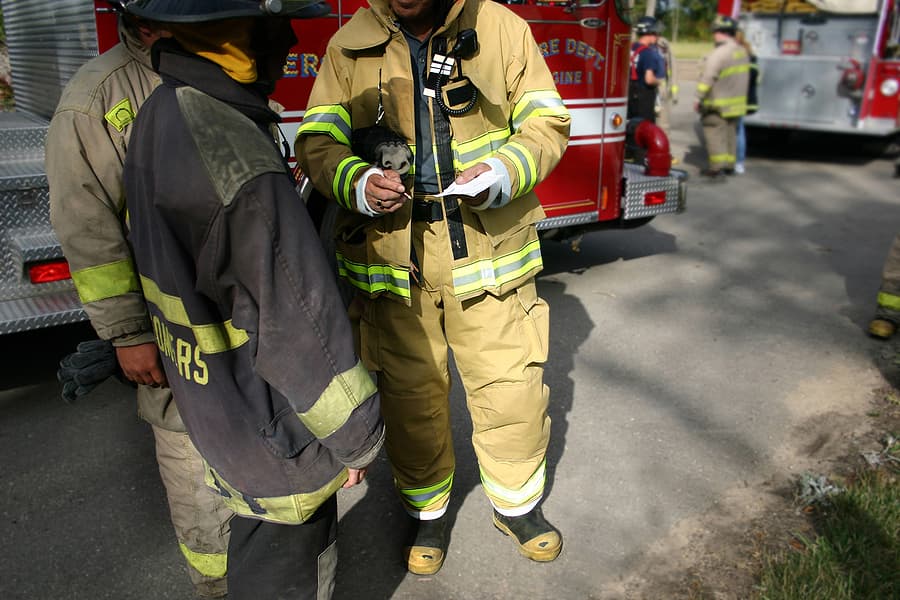9/11 Zadroga Act Lawyers… What Is the Zadroga Act?

More than 20 years have passed since the terror attacks of 9/11. Unfortunately, for many of the first responders, general responders, or survivors who lived, worked, or attended school or daycare in lower Manhattan on the day of the attacks or in the months that followed, the nightmare continues. Even now, they suffer from illnesses due to their exposure to toxins released when the World Trade Center towers collapsed and during the eight and a half months of cleanup that followed. Below you can learn: What Is the Zadroga Act?
Thanks to the 9/11 Zadroga Act, federal funds can compensate for the expenses and impacts of 9/11-related injuries and illnesses. It also provides medical treatment and monitoring of 9/11-related health conditions.
If you were at any of the attack sites on 9/11 (anywhere in lower Manhattan south of Canal Street) or the months that followed and you now suffer from any cancer or other illness you may think is linked to 9/11-related toxic exposure (the toxins are a known and proven cause of over 70 different cancers), the 9/11 Zadroga Act lawyers at Hansen & Rosasco want to help you explore your eligibility for a 9/11cash award and free lifetime healthcare benefits.
What Is the Zadroga Act?
Congress passed The James Zadroga 9/11 Health and Compensation Act in late 2010 and then-President Barack Obama signed it into law on January 2, 2011. The Zadroga Act created a federal healthcare program, the World Trade Center Health Program, to monitor and treat 9/11-related medical conditions.
The 9/11 Zadroga Act also reauthorized the September 11th Victim Compensation Fund (VCF) to provide compensation for 9/11 first responders, general responders, and survivors (downtown residents, workers, and students) who suffer or have suffered from adverse effects from their exposure to toxins in the air and environment stemming from the attacks.
The September 11th Victim Compensation Fund (VCF)
Congress created the original VCF days after the 9/11 terrorist attacks. Initially, the program compensated injured responders, survivors, and the families of individuals who died in the 9/11 attacks. That original VCF wound up its operations in 2004 after paying compensation to thousands of claimants.
In 2011, the 9/11 Zadroga Act reauthorized the VCF program, putting in place new, broader eligibility criteria recognizing that many individuals had developed severe illnesses, including cancers and respiratory diseases, from exposure to toxins at Ground Zero in Manhattan.
The VCF requires individuals with a claim for benefits to first register for the program. Registration is not the same as filing a claim for VCF benefits. It is a simple process that you or your 9/11 lawyer can complete online.
You can register with the VCF even if you have not yet fallen ill with a 9/11-related health condition. But if you do have a 9/11-related health condition, you must complete your registration within two years of diagnosis being certified by the WTC Health Program (see below). If you treat with a private physician, you most likely still have time to register even if more than two years (or even if 20 years have passed) have passed since you got sick. We have previously written about the certification process for a health condition here.
The VCF pays different types of compensation depending on the circumstances surrounding the claim. Responders or survivors who became ill with a covered health condition can file claims for income and non-economic (pain and suffering) losses. The family members of responders or survivors who died as a result of a 9/11-related illness or injury can seek compensation through the VCF as well, through a wrongful death claim.
The 9/11 Zadroga Act initially approved five years of funding for the reauthorized VCF. In 2015, President Obama signed a bill continuing the program for another five years. In 2019, President Trump signed a bill into law that permanently authorized and funded the program through October 2090. The permanent authorization law was named “The Never Forget the Heroes: James Zadroga, Ray Pfeifer, and Luis Alvarez Permanent Authorization of the September 11th Victim Compensation Fund.”
Currently, VCF caps non-economic (pain and suffering) damages at $90,000 per non-cancer condition and $250,000 for covered cancers. Claimants are permitted to seek separate compensation for each 9/11-related condition they suffer from, plus economic losses such as past medical expenses and lost wages/benefits.
The World Trade Center (WTC) Health Program
The WTC Health Program is a federal health program administered by the National Institute for Occupational Safety and Health (NIOSH) and the Centers for Disease Control and Prevention (CDC). The program provides no-cost medical monitoring and treatment for covered conditions to individuals who can prove that they were present for a sufficient amount of time at one of the 9/11 terror attack or cleanup sites during the period in which a toxic exposure may have occurred.
The WTC Health Program also “certifies” program participants’ covered health conditions. This certification can satisfy some of the eligibility requirements for receiving VCF benefits.
To obtain the benefits of the WTC Health Program, participants must seek treatment through one of several Clinical Centers of Excellence located in the New York City area, or other regions through the program’s Nationwide Provider Network. Many major world-class hospitals participate as in-network providers for the WTCHP, including the Memorial Sloan Kettering Cancer Center.
Who Was James Zadroga?
James Zadroga was a detective with the NYPD on September 11, 2001. He responded to the World Trade Center immediately after the attack and began assisting the people injured or trapped inside the buildings. He was in one of the towers when it began to collapse but escaped. He subsequently spent 470 hours digging through debris during the rescue and recovery operation.
Zadroga developed a cough shortly after the rescue and recovery operations concluded, along with shortness of breath, acid reflux, and recurring headaches. Within months, he was using oxygen tanks. He was granted a 75 percent disability pension in 2004 and died in January 2006 from complications of respiratory diseases, black lung, and mercury damage to his brain.
A 13-year veteran of the NYPD, he left behind a four-year-old daughter and a legacy of selflessness. His death is largely credited with bringing national attention to the health problems plaguing those exposed to the toxic dust that blanketed Lower Manhattan after the towers collapsed.
Who Is Eligible for Assistance Through the Zadroga Act?
Individuals eligible to obtain medical monitoring and treatment through the WTC Health Program, and compensation from the VCF, include:
- WTC Responders: Workers and volunteers who participated in the rescue, recovery, and cleanup operations or as support staff for those operations and were in an impacted area for an established duration of time between September 11, 2001, and July 31, 2002.
- WTC Survivors: People who lived, worked, spent extended time in, or attended school or daycare in Lower Manhattan between September 11, 2001, and July 31, 2002.
- Responders at the Pentagon and Shanksville attack sites.
In addition to a demonstrated presence at one of the terror attack sites, participants in 9/11 Zadroga Act programs must also be able to demonstrate that they suffer, or are at risk of suffering, from a covered 9/11-related medical condition.
Covered conditions include:
- Acute injuries, such as burns, eye injuries, fractures, or head trauma.
- Airway and digestive disorders, including asthma, chronic cough syndrome, chronic rhinosinusitis, gastroesophageal reflux disorder (GERD), and more.
- Cancers, including those involving the blood and lymphoid tissue, breast cancer, childhood cancers, those impacting the eye and orbit, reproductive system cancers, mesothelioma, cancers involving the lung and bronchus, skin, thyroid, or the urinary system. Very recently, the program administrators considered adding and will likely approve uterine cancer as a coverable condition.
The most reliable way to determine your eligibility to participate in the WTC Health Program and/or the VCF is to speak, for free, with a skilled 9/11 benefits attorney from Hanson & Rosasco.
Let Us Help You Obtain the Benefits You Deserve
On September 17, 2001, then-EPA Administrator Christine Todd Whitman mistakenly told the public that the air around Lower Manhattan was safe to breathe. Unfortunately, the air in the area was still toxic and would remain so for many months. Hundreds of thousands of people continued to work and live within the contaminated area while the danger of toxic exposure was extremely high.
The team of lawyers and legal professionals at Hansen & Rosasco accepted its first 9/11-related case just days after the terror attacks, and we have been helping those impacted by 9/11 ever since. We have assisted more than 3,000 responders, survivors, and their family members to recover nearly half a billion dollars in needed compensation.
As important as these programs are for the 9/11 community, obtaining benefits is often a time-consuming and frustrating endeavor. Our team assists clients with WTC Health Program applications and VCF claims, ensuring they have the required documentation to get the services and benefits our clients need. We also represent clients in appeals of WTC Health Program and VCF decisions.
As the only law firm in the nation that works exclusively with 9/11 survivors, responders, and their families, we have the experience necessary to handle any case relating to eligibility for 9/11 Zadroga Act benefits.
For a free evaluation of your rights to receive benefits under the 9/11 Zadroga Act, contact us online or call us toll-free at (855) 353-4907.More than 20 years have passed since the terror attacks of 9/11. Unfortunately, for many of the first responders, general responders, or survivors who lived, worked, or attended school or daycare in lower Manhattan on the day of the attacks or in the months that followed, the nightmare continues. Even now, they suffer from illnesses due to their exposure to toxins released when the World Trade Center towers collapsed and during the eight and a half months of cleanup that followed. Below you can learn: What Is the Zadroga Act?
Thanks to the 9/11 Zadroga Act, federal funds can compensate for the expenses and impacts of 9/11-related injuries and illnesses. It also provides medical treatment and monitoring of 9/11-related health conditions.
If you were at any of the attack sites on 9/11 (anywhere in lower Manhattan south of Canal Street) or the months that followed and you now suffer from any cancer or other illness you may think is linked to 9/11-related toxic exposure (the toxins are a known and proven cause of over 70 different cancers), the 9/11 Zadroga Act lawyers at Hansen & Rosasco want to help you explore your eligibility for a 9/11cash award and free lifetime healthcare benefits.
What Is the Zadroga Act?
Congress passed The James Zadroga 9/11 Health and Compensation Act in late 2010 and then-President Barack Obama signed it into law on January 2, 2011. The Zadroga Act created a federal healthcare program, the World Trade Center Health Program, to monitor and treat 9/11-related medical conditions.
The 9/11 Zadroga Act also reauthorized the September 11th Victim Compensation Fund (VCF) to provide compensation for 9/11 first responders, general responders, and survivors (downtown residents, workers, and students) who suffer or have suffered from adverse effects from their exposure to toxins in the air and environment stemming from the attacks.
The September 11th Victim Compensation Fund (VCF)
Congress created the original VCF days after the 9/11 terrorist attacks. Initially, the program compensated injured responders, survivors, and the families of individuals who died in the 9/11 attacks. That original VCF wound up its operations in 2004 after paying compensation to thousands of claimants.
In 2011, the 9/11 Zadroga Act reauthorized the VCF program, putting in place new, broader eligibility criteria recognizing that many individuals had developed severe illnesses, including cancers and respiratory diseases, from exposure to toxins at Ground Zero in Manhattan.
The VCF requires individuals with a claim for benefits to first register for the program. Registration is not the same as filing a claim for VCF benefits. It is a simple process that you or your 9/11 lawyer can complete online.
You can register with the VCF even if you have not yet fallen ill with a 9/11-related health condition. But if you do have a 9/11-related health condition, you must complete your registration within two years of diagnosis being certified by the WTC Health Program (see below). If you treat with a private physician, you most likely still have time to register even if more than two years (or even if 20 years have passed) have passed since you got sick. We have previously written about the certification process for a health condition here.
The VCF pays different types of compensation depending on the circumstances surrounding the claim. Responders or survivors who became ill with a covered health condition can file claims for income and non-economic (pain and suffering) losses. The family members of responders or survivors who died as a result of a 9/11-related illness or injury can seek compensation through the VCF as well, through a wrongful death claim.
The 9/11 Zadroga Act initially approved five years of funding for the reauthorized VCF. In 2015, President Obama signed a bill continuing the program for another five years. In 2019, President Trump signed a bill into law that permanently authorized and funded the program through October 2090. The permanent authorization law was named “The Never Forget the Heroes: James Zadroga, Ray Pfeifer, and Luis Alvarez Permanent Authorization of the September 11th Victim Compensation Fund.”
Currently, VCF caps non-economic (pain and suffering) damages at $90,000 per non-cancer condition and $250,000 for covered cancers. Claimants are permitted to seek separate compensation for each 9/11-related condition they suffer from, plus economic losses such as past medical expenses and lost wages/benefits.
The World Trade Center (WTC) Health Program
The WTC Health Program is a federal health program administered by the National Institute for Occupational Safety and Health (NIOSH) and the Centers for Disease Control and Prevention (CDC). The program provides no-cost medical monitoring and treatment for covered conditions to individuals who can prove that they were present for a sufficient amount of time at one of the 9/11 terror attack or cleanup sites during the period in which a toxic exposure may have occurred.
The WTC Health Program also “certifies” program participants’ covered health conditions. This certification can satisfy some of the eligibility requirements for receiving VCF benefits.
To obtain the benefits of the WTC Health Program, participants must seek treatment through one of several Clinical Centers of Excellence located in the New York City area, or other regions through the program’s Nationwide Provider Network. Many major world-class hospitals participate as in-network providers for the WTCHP, including the Memorial Sloan Kettering Cancer Center.
Who Was James Zadroga?
James Zadroga was a detective with the NYPD on September 11, 2001. He responded to the World Trade Center immediately after the attack and began assisting the people injured or trapped inside the buildings. He was in one of the towers when it began to collapse but escaped. He subsequently spent 470 hours digging through debris during the rescue and recovery operation.
Zadroga developed a cough shortly after the rescue and recovery operations concluded, along with shortness of breath, acid reflux, and recurring headaches. Within months, he was using oxygen tanks. He was granted a 75 percent disability pension in 2004 and died in January 2006 from complications of respiratory diseases, black lung, and mercury damage to his brain.
A 13-year veteran of the NYPD, he left behind a four-year-old daughter and a legacy of selflessness. His death is largely credited with bringing national attention to the health problems plaguing those exposed to the toxic dust that blanketed Lower Manhattan after the towers collapsed.
Who Is Eligible for Assistance Through the Zadroga Act?
Individuals eligible to obtain medical monitoring and treatment through the WTC Health Program, and compensation from the VCF, include:
- WTC Responders: Workers and volunteers who participated in the rescue, recovery, and cleanup operations or as support staff for those operations and were in an impacted area for an established duration of time between September 11, 2001, and July 31, 2002.
- WTC Survivors: People who lived, worked, spent extended time in, or attended school or daycare in Lower Manhattan between September 11, 2001, and July 31, 2002.
- Responders at the Pentagon and Shanksville attack sites.
In addition to a demonstrated presence at one of the terror attack sites, participants in 9/11 Zadroga Act programs must also be able to demonstrate that they suffer, or are at risk of suffering, from a covered 9/11-related medical condition.
Covered conditions include:
- Acute injuries, such as burns, eye injuries, fractures, or head trauma.
- Airway and digestive disorders, including asthma, chronic cough syndrome, chronic rhinosinusitis, gastroesophageal reflux disorder (GERD), and more.
- Cancers, including those involving the blood and lymphoid tissue, breast cancer, childhood cancers, those impacting the eye and orbit, reproductive system cancers, mesothelioma, cancers involving the lung and bronchus, skin, thyroid, or the urinary system. Very recently, the program administrators considered adding and will likely approve uterine cancer as a coverable condition.
The most reliable way to determine your eligibility to participate in the WTC Health Program and/or the VCF is to speak, for free, with a skilled 9/11 benefits attorney from Hanson & Rosasco.
Let Us Help You Obtain the Benefits You Deserve
On September 17, 2001, then-EPA Administrator Christine Todd Whitman mistakenly told the public that the air around Lower Manhattan was safe to breathe. Unfortunately, the air in the area was still toxic and would remain so for many months. Hundreds of thousands of people continued to work and live within the contaminated area while the danger of toxic exposure was extremely high.
The team of lawyers and legal professionals at Hansen & Rosasco accepted its first 9/11-related case just days after the terror attacks, and we have been helping those impacted by 9/11 ever since. We have assisted more than 3,000 responders, survivors, and their family members to recover nearly half a billion dollars in needed compensation.
As important as these programs are for the 9/11 community, obtaining benefits is often a time-consuming and frustrating endeavor. Our team assists clients with WTC Health Program applications and VCF claims, ensuring they have the required documentation to get the services and benefits our clients need. We also represent clients in appeals of WTC Health Program and VCF decisions.
As the only law firm in the nation that works exclusively with 9/11 survivors, responders, and their families, we have the experience necessary to handle any case relating to eligibility for 9/11 Zadroga Act benefits.
For a free evaluation of your rights to receive benefits under the 9/11 Zadroga Act, contact us online or call us toll-free at (855) 353-4907.



